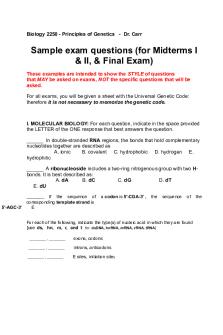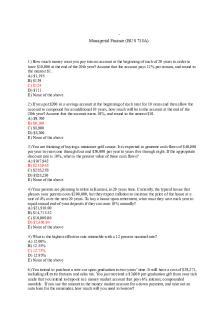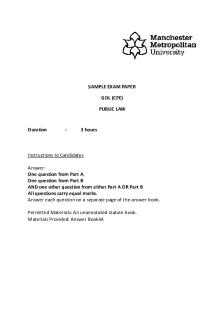Exam, questions PDF

| Title | Exam, questions |
|---|---|
| Course | Microeconomics |
| Institution | University of Technology Jamaica |
| Pages | 8 |
| File Size | 298.6 KB |
| File Type | |
| Total Downloads | 14 |
| Total Views | 153 |
Summary
Download Exam, questions PDF
Description
UNIVERSITY OF TECHNOLOGY, JAMAICA SCHOOL OF BUSINESS ADMINSTRATION ECO 1001: INTRODUCTION TO MICROECONOMICS TUTORIAL# 4 (SOLUTION) CONSUMER CHOICE / UTILITY 1. Explain the concept of budget constraint. A budget constraint separates those combinations of goods and services that are available, given limited income, from those that are not. The budget constraint can be represented by the equation PX X Py Y I (tutors may illustrate the budget line)
The budget line represents all the combination of goods for which consumers expend all their income. The budget line will shift outward in response to an increase in consumer income. When the price of one good (on the horizontal axis) changes while income and the price of the other good do not, budget lines pivot and rotate about a fixed point (on the vertical axis) 2. Show graphically and explain how the x-intercept, the y-intercept and the slope of the budget line changes for each of the following scenarios a) The price of X changes. When the price of good decreases, the budget constraint swivels to the right, increasing the opportunities available and expanding choice (vise versa for price increase). If only Px decrease, the x-intercept increases without any change in the y-intercept. A decrease in the price of x also makes budget line flatter (vise versa for a price increase). The graph below illustrates an decrease in the Px
b) The price of Y changes. 1
A change in the price of y will have no effect on the x-intercept of the budget line. Thus an increase in the price of y causes the budget line to pivot downward and a fall in the price of y causes the budget line to pivot upward. Increasing the price of good y makes budget line flatter.
c) Money income change. A change in income without any change in prices will change the intercepts but not the slope. So the budget line will shift out (if Income rises) or in (if income falls) in a parallel manner.
3. Suppose Sandra has $16.00 to spend only on ripe bananas and plums. Ripe bananas cost $0.80 each and plums cost $0.20 each. a) Write down the algebraic equation for Sandra’s budget constraint. Pb B Pp P I $0.80 B $0.20 P 16
b) If Sandra buys only ripe bananas, calculate how many bananas can be bought? B
$16 I 20 Pb $0.8
c) If Sandra buys only plums, calculate how many plums can be bought? P
I $16 80 $0. 2 Pp
d) If Sandra were to buy 12 ripe bananas, how many plums could be bought with the funds left over? 2
(0.8*12) +0.2Plums=$16 solving for plums= 32 e) If Sandra consumes one less ripe banana (i.e. 11) how many more plums could be bought? (0.8*11) +0.2Plums=$16 solving for plums= 36; the consumer can purchase 36-32= 4 more f) Is the rate of trade off the same no matter how many ripe bananas are relinquished? Yes, as long as prices remain the same g) Calculate the opportunity cost of ripe bananas for Sandra? the opportunity cost of 1 banana = 4 plums h) Calculate the opportunity cost of ripe plums for Sandra? the opportunity 1 plum = 0.25 banana. i) Graph the Sandra’s budget showing the points mentioned in (a) - (d).
4. What is the difference between ordinal utility and cardinal utility? Utility means satisfaction which a consumer derives from commodities and services. There are mainly two kinds of measurement of utility implemented by economists: cardinal utility and ordinal utility. Cardinal utility means satisfaction that can be measured in numbers such as 1, 2, and 3. While ordinal utility refers to satisfaction cannot be measureable in numbers. 5. Explain the basic assumptions about individual preferences There are three fundamental assumptions concerning individual preferences: 1. Completeness - given any two bundles A and B the individual either prefers A to B, B to A, or is indifferent between them 2. Consistency (Transitivity) - given any three bundles A, B and C, if A is preferred to B and B to C then A must be preferred to C. 3. Non-satiation - the consumer always prefers more to less. So if bundle A contains more of at least one good and no less of any other than bundle B, then bundle A is preferred to B
6. Differentiate between total and marginal utility.
3
Total utility is the total amount of satisfaction obtained from consumption of a good or service whilst marginal utility is the additional satisfaction gained by the consumption or use of one more unit of a good 7. Explain the law of diminishing marginal utility. Law of diminishing marginal utility The more of any one good consumed in a given period, the less satisfaction (utility) generated by consuming each additional (marginal) unit of the same good. 8. The table below shows how the total utility that Zach derives from eating candy bars changes as he consumes more and more candy bars each day: Candy Total Marginal Bars Utility Utility 0 20 1 20 2 35 15 3 47 12 4 47 0 5 45 -2 a) Compute the marginal and total utility in the table b) Do the numbers in the table support the law of diminishing marginal utility? Explain your answer. yes as TU rises , MU falls c) At what point does diminishing marginal utility sets in? after the 1st candy d) At what point is utility maximized? at the 4th candy 9. Explain the concept of indifferences curves. An indifference curve is a set of points, each representing a combination of some amount of good X and some amount of good Y, that all yield the same amount of total utility. The consumer depicted here is indifferent between bundles a and B, B and C, and a and C. Because “more is better,” our consumer is unequivocally worse off at A' than at A.
Each consumer has a unique family of indifference curves called a preference map. Higher indifference curves represent higher levels of total utility. 4...
Similar Free PDFs

Exam, questions
- 1 Pages

Exam Questions
- 9 Pages

Exam, questions
- 7 Pages

Exam, questions
- 9 Pages

Exam, questions
- 62 Pages

Exam, questions
- 8 Pages

Exam, questions
- 5 Pages

Exam, questions
- 5 Pages

Exam, questions
- 2 Pages

Exam, questions
- 10 Pages

Exam, questions
- 2 Pages

Exam, questions
- 24 Pages

EXAM, questions
- 6 Pages

Exam, questions
- 8 Pages

Exam, questions
- 21 Pages

Neuro Exam questions - Past exam
- 12 Pages
Popular Institutions
- Tinajero National High School - Annex
- Politeknik Caltex Riau
- Yokohama City University
- SGT University
- University of Al-Qadisiyah
- Divine Word College of Vigan
- Techniek College Rotterdam
- Universidade de Santiago
- Universiti Teknologi MARA Cawangan Johor Kampus Pasir Gudang
- Poltekkes Kemenkes Yogyakarta
- Baguio City National High School
- Colegio san marcos
- preparatoria uno
- Centro de Bachillerato Tecnológico Industrial y de Servicios No. 107
- Dalian Maritime University
- Quang Trung Secondary School
- Colegio Tecnológico en Informática
- Corporación Regional de Educación Superior
- Grupo CEDVA
- Dar Al Uloom University
- Centro de Estudios Preuniversitarios de la Universidad Nacional de Ingeniería
- 上智大学
- Aakash International School, Nuna Majara
- San Felipe Neri Catholic School
- Kang Chiao International School - New Taipei City
- Misamis Occidental National High School
- Institución Educativa Escuela Normal Juan Ladrilleros
- Kolehiyo ng Pantukan
- Batanes State College
- Instituto Continental
- Sekolah Menengah Kejuruan Kesehatan Kaltara (Tarakan)
- Colegio de La Inmaculada Concepcion - Cebu